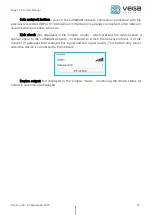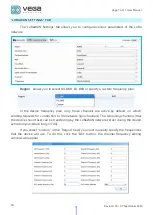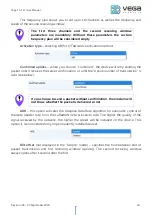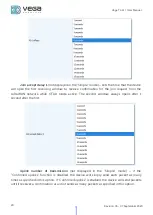
Vega TL-11 / User Manual
5
Revision 03 - 07 September 2020
1 DESCRIPTION AND OPERATION
Logger designed for a long autonomic collection and storing of a data about controlled
environment (air, non-aggressive gases, liquids, bulk materials, food). Temperature is
measuring through two thermistors: external probe connecting to the logger and built-in
external temperature sensor. The device archives temperature measurements with the time
check at the device memory and then transmits that archived data in the LoRaWAN network
when there is a stable radio connection.
The device may operate autonomically and collect temperature readings during a
month while the data collection period is 30 minutes.
Logger Vega TL-11 may be used in systems where it's needed to control the
temperature through the long time without ability to operatively transmit data to the network,
for example, when transporting perishable goods or when it’s needed to control the
transportation conditions. In transit the device puts product temperature values to the
memory and when it's come to the destination the device will transmit saved data to the
LoRaWAN network.
TL-11 is powered by a 6400 mAh built-in battery with service life up to 10 years,
provided data transmitted once a day.
COMUNICATION AND DATA COLLECTION ALGORITHM
The readings collecting from the thermistor with a configurable period from 5 minutes
to 24 hours. The readings stored in the device memory and transmitting during the next
communication session with the LoRaWAN network.
Data collection period when measurements are out of specified temperature range set
independently and may be equal from 5 minutes to 24 hours.
The adjustable data transfer period can be from 5 minutes to 24 hours. Data
transferring in random point in time during set period. At the next communication session, the
device starts sending accumulated packets with readings, from the earliest to the latest.
With the "Confirmed uplinks" option turned on, the device will send the next packet
only after receiving a confirmation of the delivery of the previous one. If such confirmation
has not received after the fulfilled in the settings uplink number of transmissions, device
completes the communication session until the next one according to the schedule. In this
case, the device continues to collect data according to the data collection period and store it
in memory. Non-transmitted packets remain in the device memory until the next
communication session.
With the "Confirmed uplinks" option turned off, the device just sends all accumulated
packets to the network in order from the earliest to the latest. There are no checks of package
delivery in this mode. There are no non-transmitted messages in the device memory.






































